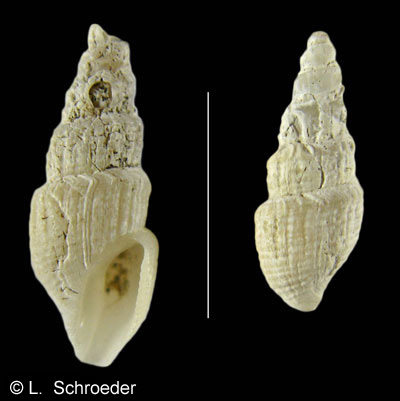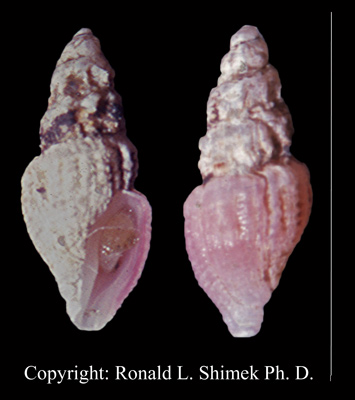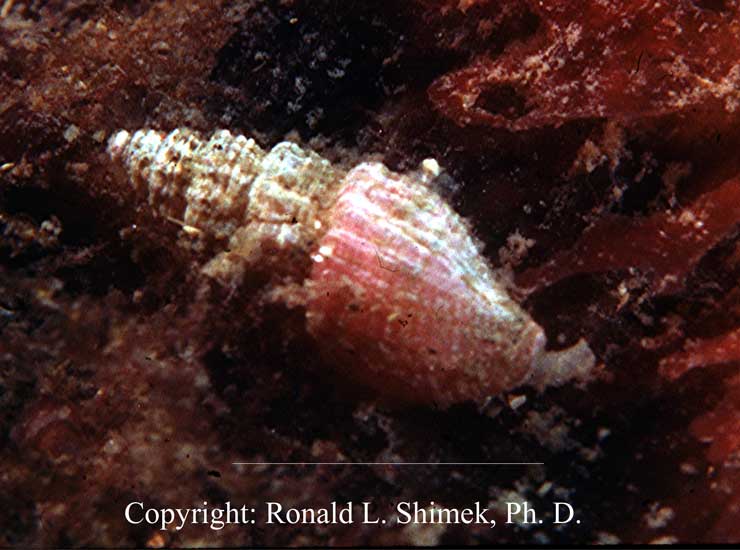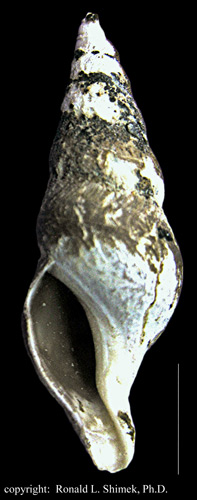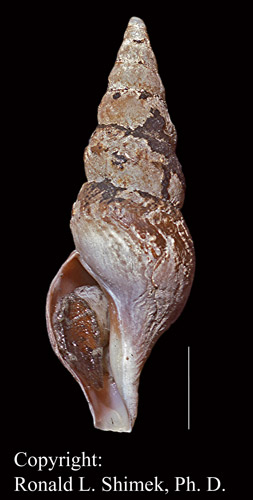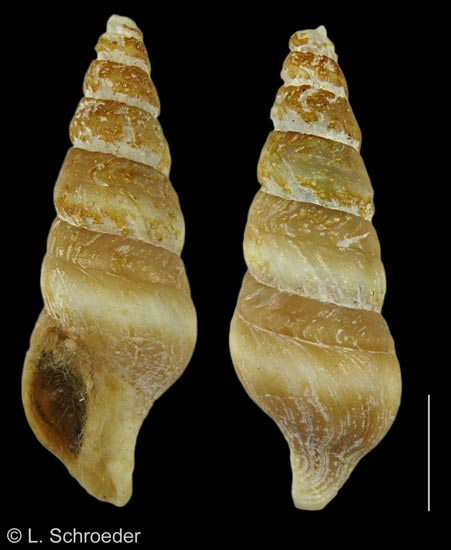Click on photo to enlarge. Scale line in photo equals 1cm unless otherwise specified.
* Species which are commonly encountered on the beach.
Mangeliidae
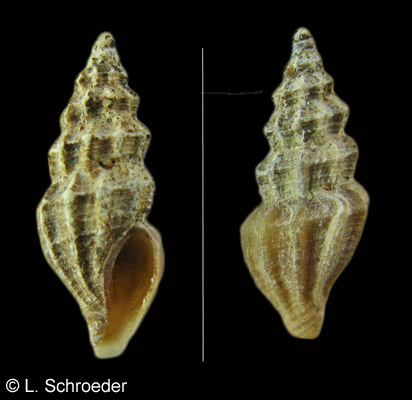
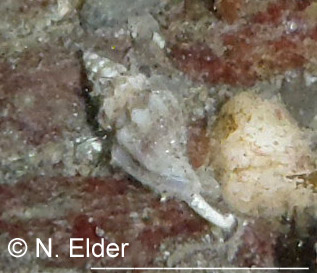
off Ucluelet, BC
Freshwater Bay, WA, subtidal
Kurtzia arteaga (Dall & Bartsch, 1910)Beaded Mangelia
subtidal to at least 114m size to 10mm
northern Mexico to central BC
This species has axial ribs and spiral cords which give it a beaded effect where they cross.
(synonyms - Mangilia arteaga, Kurtzia gordoni)
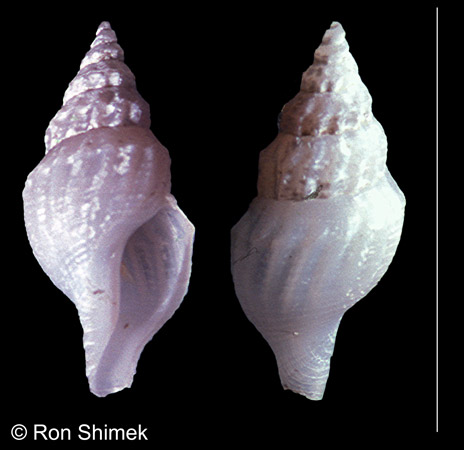
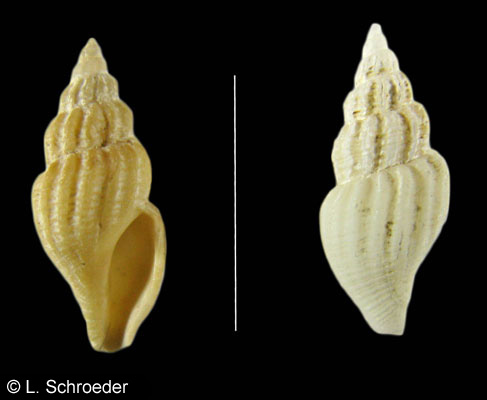
San Juan
Islands, WA
San Juan Islands, WA
Oenopota elegans (Möller, 1842)Elegant Lora
subtidal size to 18mm
circumboreal, extending south to Washington, Maine, northern Europe
This
shell has prominent axial ribs which are slightly angled down the
shell. It also exhibits smaller spiral ridges. They are
typically found on silt/mud in fairly shallow water.
(synonyms - Propebela elegans, Lora elegans, Defrancia elegans, Lora galgana)
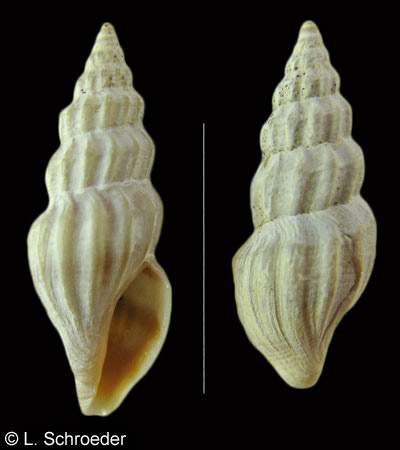 Neah Bay, WA
Neah Bay, WA
Mangelia crebricostata Carpenter, 1864
Violet-Band Mangelia
intertidal to 85m size to 15mm
northern Washington to Alaska
This
is rarely found intertidally. The shell is white to tan with a
darker brown to violet spiral band. Look for it in sand or
sand/mud habitat feeding on polychaete tube worms.
(synonyms - Kurtziella crebricostata, Oenopota crebricostata)
The Oenopota
can be very difficult to identify. Any identification is a "best
guess", but our best guess was done by Pacific Northwest turrid
authority, Dr. Ron Shimek. There has yet to be any DNA work done on specimens from the northeast Pacific to verify their relationships.
Gastropods
Family Borsoniidae, Mangeliidae
& Pseudomelatomidae
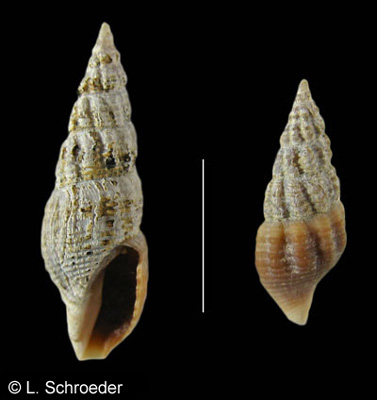
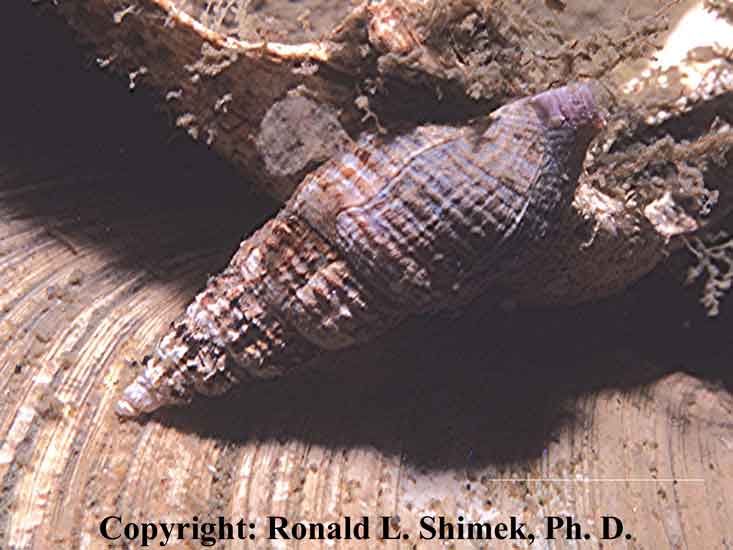
off Victoria, BC
San Juan Islands, WA, subtidal
Oenopota levidensis (Carpenter, 1864)
subtidal Washington to Alaska size to 20mm
This
shell has a very tall spire with wide axial ribs. It may be orangish
brown to reddish brown. This is one of the most common Oenopota in our area.
(previous name - Mangelia levidensis)
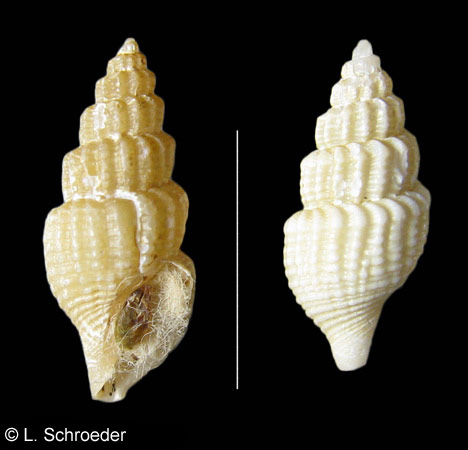 San Juan Islands, WA
San Juan Islands, WA
Propebela fidicula (Gould, 1849)
subtidal size to at least 12mm
Washington to Alaska
This shell has axial ribs, spiral ridges and squared shoulders. The snail lives on or near rocks.
(synonyms - Oenopota fidicula, Canetoma fidicula)
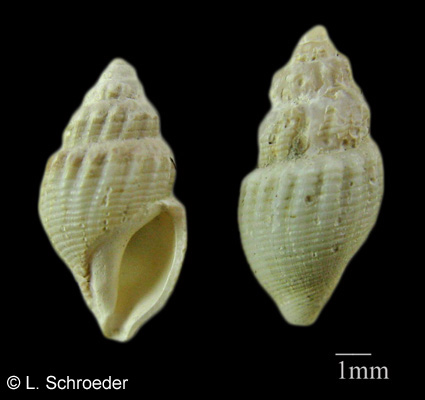 Howe Sound, BC
Howe Sound, BC
Oenopota excurvata (Carpenter, 1864)
subtidal size to at least 10mm
Puget Sound to Bering Sea
This shell has axial ribs, closely spaced spiral ridges and distinct shoulders.
(previous name - Bela excurvata)
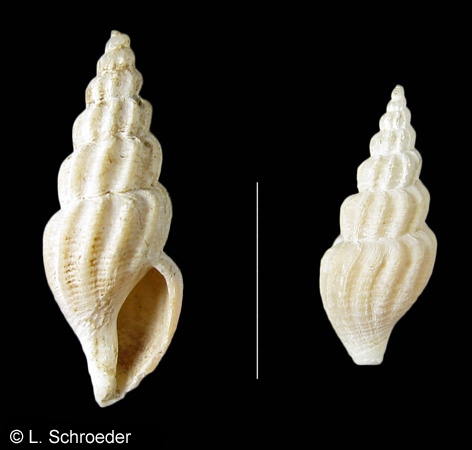 San Juan Islands, WA
San Juan Islands, WA
Oenopota pyramidalis (Strom, 1788)Pyramid Lora
subtidal, 9-466m size to 20mm
Puget Sound to Bering Sea; Massachusetts to Arctic Canada; Norway
This
shell has angled axial ribs and fine spiral lines. The spire is
somewhat high. It is usually found on rocks/gravel in deeper
water. Very similar appearance to O. elegans but they have different radulae.
(synonyms - Buccinum pyramidalis, Fusus pleurotomarius)
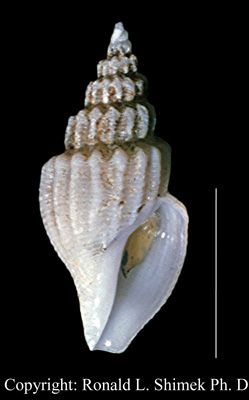 San Juan Islands, WA
San Juan Islands, WA
Propebela turricula (Montagu, 1803)Turriculate Lorasubtidal, 9-347m size to 15mmWashington to Bering Sea; Massachusetts to ArcticThis shell has weak axial ribs and fine spiral lines. It has squared shoulders.(synonyms - Oenopota turricula, Murex turricula)
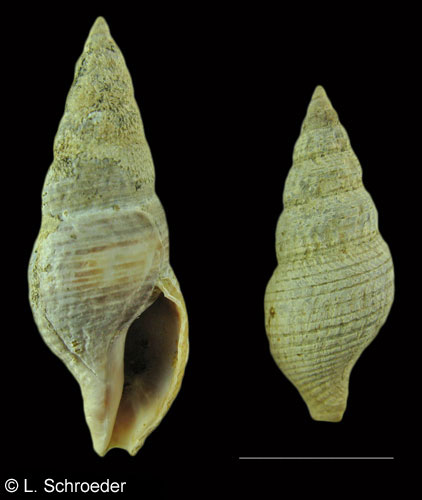
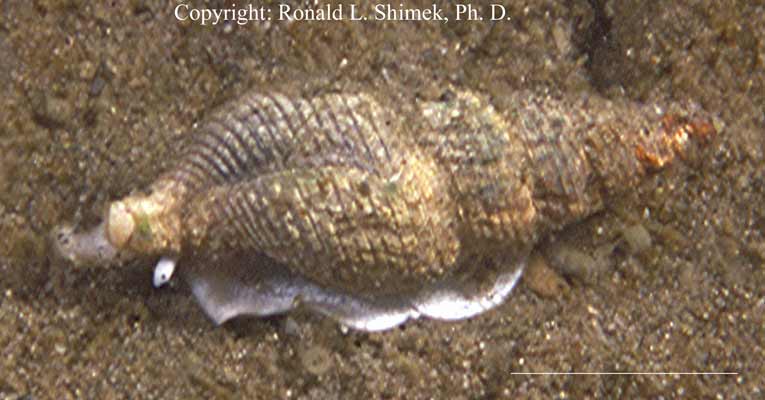
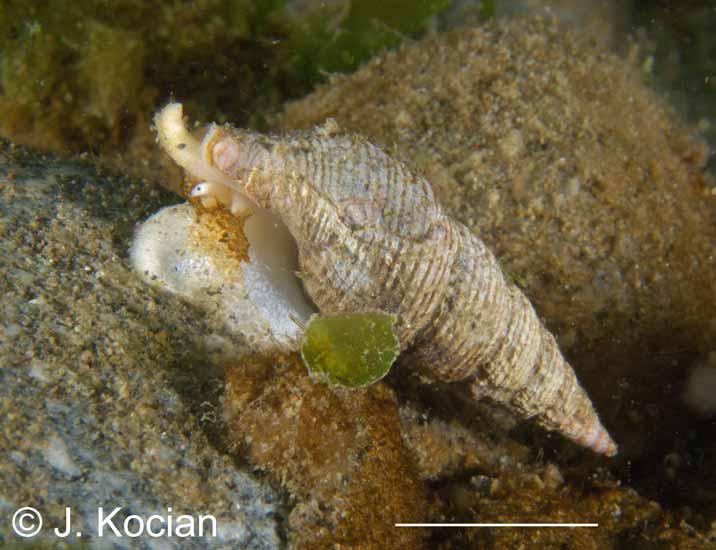
Dyes Inlet, WA
Dyes Inlet, WA, subtidal
Whidbey Island,
WA, subtidal
Ophiodermella inermis (Reeve, 1843)
Gray Snakeskin-Snail
intertidal
to 70m northern Mexico to northern BC
size to 40mm
This
is infrequently found intertidally. This tall-spired shell
has fine spiral grooves. Brown, wavy axial lines give it its name.
(synonyms - Ophiodermella ophiodermella, Ophiodermella incisa, Ophiodermella halcyonis, Ophiodermella montereyensis, Moniliopsis incisa, Pleurotoma inermis)
Borsoniidae
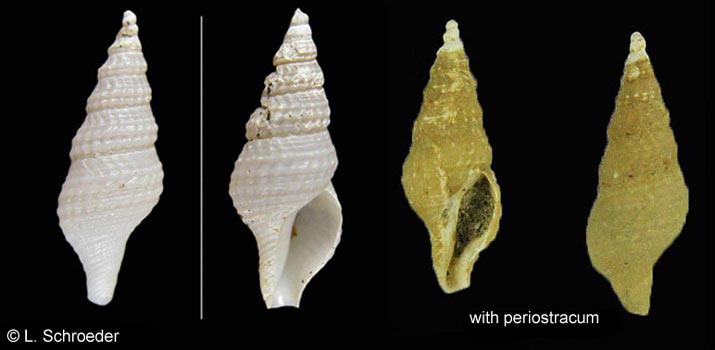 Barkley Sound, BC
Barkley Sound, BC
Ophiodermella cancellata (Carpenter, 1864)Cancellate Snakeskin-Snail
subtidal, 50-500m southern California to BC size to 13mm
This
shell has cancellate sculpture. The white shell is covered with a
brown periostracum. It lives in sandy/silty areas.
(synonyms - Ophiodermella rhines, Pleurotoma vancouverensis)
This page last revised: 7-1-2024
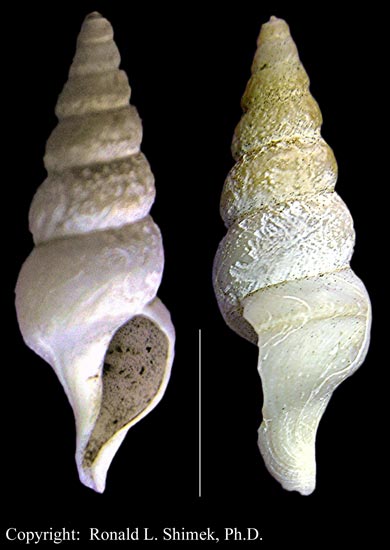 Barkley Sound, BC
Barkley Sound, BC
Antiplanes sp.
subtidal size to at least 40mm
probably California to Alaska
This is a dextral species. This may be Antiplanes thalaea.










